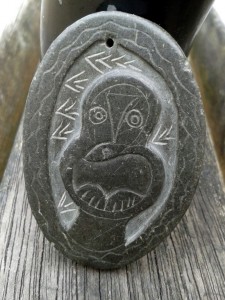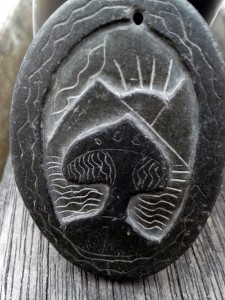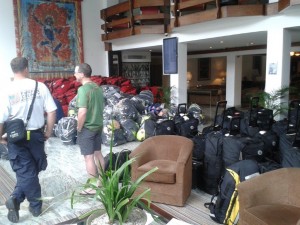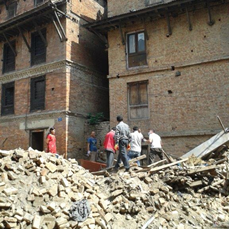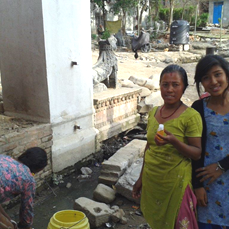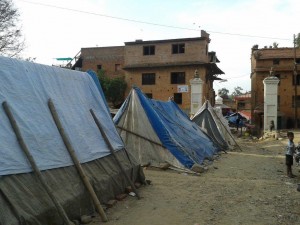I wrote this article back in 1992 and decided to run it past a journalist friend, Robin Eggar before seeking its publication. He pilloried it to such an extent that I thought oh well, a writing career is not for me and I abandoned the project. Since then he has betrayed me royally on at least two occasions. Strange isn’t it how one’s perceived mates can turn out to be ‘smiling assassins’ ?
Suffer a nervous breakdown in South West London and the chances are you will be brought to Springfield Hospital. Your initial impressions may well be favourable. It is a magnificent 1841 Tudor style building, reminiscent of Hampton Court, approached by a sweeping drive and overlooking acres of parkland. You will be led to your designated ward, generally allocated by area of residence not by your specific condition, and interviewed by the doctor on duty. You are now out of the control of your G.P. and in the hands of the NHS psychiatrists. ‘Leave all love and hope behind, out of sight is out of mind’.
Since the late 1940’s treatment of mental illness has moved away from the padded cell approach to a succession of drug therapies. Chemical straight-jackets have replaced linen ones. The drugs are claimed to control and dampen the symptoms of sufferers, but in reality they do little more than render the recipients semi-comatose and thus manageable. The oldest established tranquilizer, and still the most widely prescribed, is Chlorpromazine or Largactil. Known as the ‘liquid cosh’, this drug is in everyday use not only in mental hospitals but prisons, nursing homes and even children’s homes. It is liberally used at Springfield at doses of up to 2gm per day whereas in a private clinic a patient would have to be seriously disturbed to receive as much as 250mg a day. Perhaps the second commonest tranquilizer in use is Droperidol and here again the dichotomy between NHS and private hospitals can be illustrated. The standard dose at Springfield is at least 30mg, compared to 5mg privately. This prompts the question : are these NHS patients six or more times more deranged than their middle-class counterparts ?
Other drugs in regular use here include Stelazine, Haloperidol, Modecate. Clopixol and Depixol, all prescribed at levels that would be considered obscene in the private sector. Their short-term effects are alarming enough – most patients become apathetic, sleep most of the day, their hands shake uncontrollably and muscles stiffen causing some to walk like animated scarecrows. Largactil has a particularly nasty side-effect – go outside in even weak sunshine and you will experience a burning sensation on your scalp and exposed areas of skin.
The worst side-effects, notably the Parkinsonian tremors, can be counteracted by other drugs, It is a question of exchanging one set of unwanted effects for another, hopefully more tolerable, set of side-effects, Procycladine or Kemadrin is the commonest used, but often causes dizziness, a dry mouth and blurred vision. Benhexol, Benztropine and Orphenadrine are further ‘antmuscularinics’ sometimes used,
These pills are rarely offered to patients for several reasons. There is the fear that their use can accelerate the onset of ‘tardive dyskenesia’, the term for irreversible damage caused by long-term use of major tranquilizers. Furthermore, most of these drugs have a stimulating effect and patients have been known to hoard them for a future ‘buzz’. One suspects that the hospital’s reluctance to prescribe them is predominantly for the latter reason.
Wandering around the grounds and neighbouring Tooting Bec are scores of pathetic walking wounded. Contorted faces, open mouths, drooping or tilted shoulders, shuffling gait and an odd rolling motion of the fingers are all common sights. Many patients have been resident for thirty years or more, blighted by this pernicious damage to their central nervous systems. Probably the general public attributes their strangeness to some quirk in their mental condition but these are cases of tardive dyskenesia or ‘ the late onset of difficulty of movements’. This is the worst legacy of the last 40 years of psychiatry.
A walk up to Phoenix ward confirms the view that lessons have not been learnt from this over-prescription and that little is changing. This is a mixed ward of patients in their twenties and thirties, seemingly little different from occupants of other wards apart from the sweetener of being given individual rooms rather than dormitories. There is a price to pay for such freedom, for this is known as the guinea-pig ward. Most people here are taking the latest wonder drug of the pharmaceutical industry, Clozaril, a potentially dangerous substance requiring two blood tests a week to monitor its level and which has already caused one death.
Matthew *, a former chemistry student at King’s College, University of London, who has been at Springfield for six years, is diagnosed as schizophrenic. He recently developed epilepsy, an occasional side-effect of long-term use of anti-psychotic medication, and admitted to feeling ‘pretty rough’ on Clozaril. He currently takes a cocktail of Largactil, Depixol and Clozaril four times a day, this practice of ‘polypharmacy’ or mixing of drugs being standard practice here. Many in the medical profession feel that the interaction between these chemicals has been insufficiently analysed and that this custom is unnecessary and unsafe. Poor Matthew has been through the whole gamut of psychotropic drugs during his time at Springfield – you name it, he’s taken it – tablets, liquids and injections. He and his fellows on Phoenix are destined to become the next generation of permanently damaged victims.
The prevailing air on all the wards is one of lack of care and sympathy from the staff. Doctors and nurses will sit for hours in their locked offices ignoring pleas from the patients … “No, I’m busy” seems to be their favourite refrain. Even the elderly and infirm are often left lying on the floor, by-passed by the nursing staff. People complain that they are lucky if they get to see their doctor once a week. Furthermore there is certainly no attempt at psychotherapy or counselling individuals about their thoughts and anxieties, The overriding concern of the nurses is to ensure that everyone receives their medication – those who have not yet recovered from the previous dose are rudely shaken from their sleep and led to the drugs trolley.
Of course there are exceptions amongst the nurses. A few are genuinely concerned for the welfare of their charges but much of the general care is actually carried out by the patients themselves, at least those who are capable of doing so. You would have thought that the choice to work in psychiatric nursing would foster compassion towards the mentally ill not the contempt shown by many.
This view of mental patients as third-class citizens was highlighted recently by a distressing incident. Before Christmas last year Keith, a long-stay patient at Springfield, started getting severe chest pains,. An ambulance was called and he was driven down to nearby St. George’s Hospital. After being assessed at casualty he was turned away because the doctors there didn’t want a disturbed man disrupting their wards. Keith died the following day back at Springfield. This was no isolated case; treatment for everyday physical ailments is a low priority here, let alone for emergency cases .
It is acknowledged that mass catering in NHS hospitals leaves much to be desired, but the quality of meals at Springfield is particularly poor. Out of a daily budget of £1.72 per person, 40p is allocated for lunch. Grey mashed potato. one over-boiled vegetable and maybe a meat pasty, followed by a tasteless blancmange will be typical lunchtime fare. The evening meal is sometimes merely a baked potato and baked beans. All this is delivered luke-warm in antiquated trolleys from the central kitchen. Only six months ago patients were given a cooked breakfast every day and the quality of food was said to be better. Is this the result of ‘contracting out’ the service or simply poor allocation of resources ? Suffice to say that the hospital diet is almost wholly lacking in vitamins, fruit and fibre – the fortunate ones are able to supplement it with gifts from relatives or by their own shopping. Bodies already under assault from the medication are given little succour from this diet.
The cleaning service was similarly contracted out in 1990 with negative consequences. Toilets are left in a disgusting state: urine, vomit and faeces rarely adequately cleared away; windows are cleaned just once a year. Bed linen is meant to be changed weekly but in practice this is not achieved and duvets and pillows are likely to reek unpleasantly of previous occupants’ incontinence.
While the hospital caters in the main for the mentally ill, there are many who are simply depressed and some, like Ruby, with no recognisable mental condition at all. Wheelchair-bound on Bluebell ward, she patiently passes her days in quiet contemplation. Perhaps twice a year staff will make the effort to treat her to a push around the grounds. Rarely do they have any time to bring her even a glass of squash, she says. Why can’t she be moved to a nursing home ?
Doctors like to pigeon-hole their mental patients with convenient labels describing their condition :- manic, hypomanic, manic depressive, manic depressive manic, schizo-affective, psychotic or various combinations of these terms. Few will be happy with their appellation. Indeed many diagnoses are hastily arrived at. Miles, a twent eight year old English graduate from Essex University, was asked the classic question, “Do you hear voices? at Birchill Hospital near Rochdale. “No, I don’t, but I create voices when I write plays.” After only five minutes of questions and answers along similar lines he found himself diagnosed as schizophrenic. A former voluntary patient at Springfield he can claim special prescient powers. Searching for a friend on his university campus and not knowing where she lived, he chose one of the six tower blocks at random, took the lift to the twelfth floor, went to the end of the corridor and knocked on the door. His friend answered. Peter, his twin brother, also burdened with a schizophrenic diagnosis, had a premonition of impending disaster on seeing the Marchioness manoeuvring on the Thames the afternoon before her demise.
Far from being the lower forms of life that their treatment would often suggest, many patients are among the more intelligent, creative and talented members of society. Musicians, artists and writers abound. One only has to think of past sufferers to recognise that mental illness can afflict those close to perfection in their fields … Mozart, Tchaikovsky, Van Gogh, Tolstoy, Winston Churchill and Graham Greene to name but a few. Were biblical characters immune from problems ? Isiah wandered naked round Jerusalem for seven years, John the Baptist pursued a hermit’s existence living off locusts and honey and Jesus himself was said to be ‘full of the holy spirit’ when led into the desert to be taunted by the Devil. How would his action of overturning the money-changers’ tables be construed today ? The dividing line between mental illness and true religious torment is undoubtedly narrow.
What is interesting when talking to those touched by madness is that whatever their designated label from manic through to schizophrenic, the pattern of thoughts and actions during manic phases is strikingly similar. Common to all is the feeling that what they are going through is a religious experience. A special relationship with God is claimed, a communion with the sun, the elements and nature. Birds seem to signal the way to go, leaves on trees will rustle on windless days.
There is a sensation that one has been chosen and that it is only a matter of time before one’s power becomes public knowledge. Fame and recognition seem just around the corner. Many derive inspiration from the sites and spires of churches, most will experience a surge of heightened awareness during services. Music plays a special role. The rhythm of music appears to match the rhythm of sufferers’ actions, particularly with classical pieces dedicated to God, Mozart being an especial favourite. The lyrics of rock and pop music, many of them similarly pleading to a higher authority, tend to give confirmation and credence to their manic thoughts. Likewise passages in literature from the Bible to Yeats can give messages. One patient felt he was a living book and said that he was looking forward to reading it.
Whilst these experiences seem laudable and harmless enough, there is a distaff side to the elation. The thoughts can easily become confused – sometimes there is too much information circulating round the brain and too many different ways of interpreting it. Most patients would admit to some wild and socially unacceptable behaviour during their manic phases. Their personal striving to accomplish good at the expense of evil can alienate them from friends and family, What they see as a generosity of spirit and an openness towards strangers can easily degenerate into a spending spree and consequent debt. Some will admit to considering themselves to be lost or hidden members of the Royal Family or even the Pope or Jesus.
Home life can be disrupted by sleeplessness and a tendency to rearrange possessions into the ‘correct’ order dictated by their thoughts. Obsession with colour can be a factor, black and red signifying evil and danger, yellow and gold representing good. This leads some to pull out labels from clothes and to deface books and important documents. Perhaps yet stranger are those thoughts whereby world events are felt to be influenced merely by flicking through a newspaper. Kick an empty Sony cardboard box and the Japanese economy will stumble ! They feel their mental power can penetrate the minds of others and this can lead to confrontations frightening to members of their families.
Allied to their imagined mental strength during an ‘up’ is an actual physical strength way above normal capabilities. It can take five men to administer a sedative injection to an unwilling recipient. One patient being apprehended at Heathrow Airport by six security guards still found the force to break the arm of one of his captors.
Some psychotic people are undoubtedly a danger to themselves as well as to others and need sedation as well as careful watching. But the vast majority of the six hundred or so inmates at Springfield do not belong to this category. Many seem to be kept here for unnecessarily long periods on the whim of their consultants. Even release into the community does not bring freedom from the clutches of psychiatry. At the Deepdene hostel in Streatham are ten former patients from Springfield. The atmosphere is depressingly ward-like – medication four times a day from the one resident nurse, the same zombie routine of sleep, television, coffee and cigarettes. Once again there is no attempt at counselling. One wonders how these people are expected to re-assimilate themselves into society, find jobs or partners when the drugs keep them asleep for up to eighteen hours a day.
Whatever the solution for these manic sufferers might be, it is clear that the psychiatric profession is as much in the dark as it was one hundred and fifty years ago when the first asylums like Springfield were built. Brutal physical treatment has given way to ‘megadosing’, ‘polypharmacy’ and indifferent staff. The NHS could save itself millions of pounds a year merely by reducing its dosage levels to more humane levels. The liberal use of the major tranquilizers has to be questioned and perhaps more use made of short-term pacifiers such as Valium and Ativan, combined with sympathetic listening and counselling. The acute stage of heightened anxiety for a manic patient rarely lasts more than three or four days, a similar time-span to the effectiveness of minor tranquilizers.
Further savings to the NHS could be made with an increased role being taken by the church. Certain monastic retreats already offer refuge. Buckland Abbey in Devon, Quarr Abbey on the Isle of Wight and Ampleforth in Yorkshire all provide a regime of prayer, conversation and nutritious food in peaceful surroundings that has benefited hundreds of these confused individuals. By all accounts the drug-free environment combined with an understanding community leads to a recovery far more rapid than that achieved by modern hospital psychiatry.
Given the disposition towards religious thoughts, which doctors at Springfield see as a symptom to be quashed, it would seem obvious that an expansion of the retreat system could offer a more Christian and caring approach to the problems of the mentally ill. Although many monasteries are in remote locations thus making visits from family and friends difficult, there are plenty of smaller retreats within or close to our major cities that could be encouraged to play a larger part.
Mental illness is as old as mankind itself and misunderstanding is as rife today a sin centuries past. “There is pleasure sure, in being mad, which none but madmen know.” If only the pleasures and pains of mania were better understood by the public and the profession alike, then tragic incidents like the battering to death of a young man at the Hippodrome nightclub last year could be avoided. As Hamlet said, “Though this be madness, yet there be method in’t.” Without doubt there is madness in our method of treating it today.
* Names have been changed to protect identities
